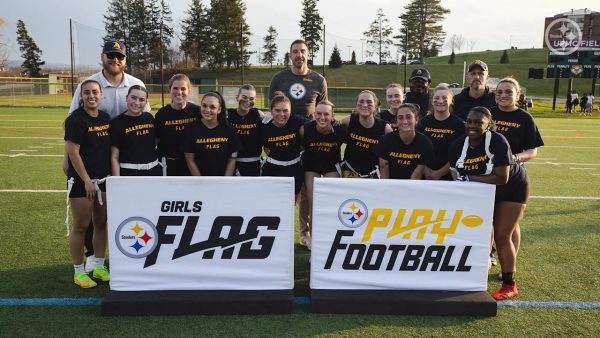Panel held to discuss the Capitol Hill riots
The Capitol Hill riots took place on Jan. 6, following former President Donald J. Trump’s rally in Washington D.C. Pro-Trump rioters gathered outside of the Capitol building and proceeded to enter the building in protest of the Senate counting electoral votes that day, which certified Joe Biden as the 46th President of the United States. Five individuals died at the event and several arrests have been made.
A panel and community discussion on the Capitol Hill riots sponsored by the Office of Institutional Diversity and the Center for Political Participation was held on Tuesday, Jan. 19 via Zoom. Members of the Allegheny College community received additional resources, such as suggestions for books and articles, for members interested in learning more about the ramifications of the Capitol Hill riots.
“The Office of Institutional Diversity heard very clearly from students in the fall and over the summer that they wanted more opportunities to have this type of engagement within our community,” Dean for Institutional Diversity Kristin Dukes said. “When these big events happen that shake us all, it is important that we can come together and have respectful dialogue about what is happening.”
The panel, on Jan. 19, included Dean of Curriculum & Registrar and Associate Professor of History and Black Studies Ian Binnington, Associate Professor and Department Chair of Political Science Shanna Kirschner and Dukes. The session was moderated by Aubrey Hall, ’22, a political science major and a CPP Fellow.
“Part of the purpose of the (CPP) — in particular for this event — is to use this unique opportunity to think about the role that higher education plays in our democracy, things that are integral to our democracy as an institution and the things that we need to be thinking about (during) this really pivotal moment in our nation’s history,” Hall said. “We would be remiss not to use this moment to examine the darker underbelly of those institutions and to think really critically about the role that we play as scholars and citizens of this country.”
Following the introduction by Hall, Dukes began to recall the events of the Capitol Hill riots and offered her perspective.
“As a Black woman and as a diversity officer, the first thing that came to mind from the moment that I saw those images on Jan. 6 … was look at this display (of) white supremacy and white privilege,” Dukes said. “Every time I looked back, the only thing that I could say was that there is no way for me to look back and not see this moment as blatant white supremacy and white privilege. When I look at the treatment of the insurrectionists versus the treatment of (Black, Indigenous and People of Color) who demonstrated (and) protested during the summer of 2020 and years before that we can go back and (look at) the use of fire hoses. The treatment of these insurrectionists that were being blatantly violent and then were being ushered out calmly and all I can think was if that was a Black person, we never would have made it that far, ever. … The white privilege of being able to walk into a place like you own it and with that level of confidence and not fearing for your life is just beyond me — I have never had that type of boldness in this body that I live in, ever.”
She also recalled symbols seen during the riots — such as the Confederate Flag — which have racist undertones and are often associated with white supremacists.
“Seeing the conflation of white nationalism and patriotism and this idea of being a ‘true patriot’ being reduced to being white and Christian,” Dukes added. “I could not help but think that this is intentional. This is an intentional show of white supremacy, white nationalism and white privilege — we cannot call it anything other than that. When we see what is happening and we call (the situation) another (name) — when we do not call a thing, a thing — that is another example of white privilege.”
Following Dukes’ initial personal reaction to the events, she recalled then analyzing the situation and what it meant for democracy. She also mentioned being pleased to see that media coverage included the usage of terms such as “domestic terrorism.”
“One of the mantras of social psychology is the power of the situation and the ability of folks to do things that they would not normally do,” Dukes said. (The Capitol Hill riots) had all of the ingredients needed to be volatile.”
Dukes summarized the actions of Trump that led to the Capitol Hill riots, including his rhetoric and persuasion regarding the election. Trump created an atmosphere of hostility by establishing an us-versus-them mentality among his supporters. According to Dukes, social psychology supports the notion that the more authoritative or charismatic an individual is seen, the more likely people are to follow them or be persuaded by them.
“It felt like cult-like behavior,” Dukes said. “I have studied the cases of cult leaders and how they led their people to these types of violent actions.”
Dukes cited the weapons effect, the idea that the presence of a weapon has the ability to make people more violent, in noting that many of the rioters had weapons.
“As I try to rationalize this behavior, which I cannot, this is a point of cognitive dissonance,” Dukes said. “With cognitive dissonance theory, it shows that sometimes we just get in too deep. We look at our behavior and we look at our attitudes and there is a disconnect between the two so we do everything that we can to bring those thoughts and actions into alignment. In doing so, we sometimes go over the edge and do things that we would not typically do, so I think about this as the ride or die mentality.”
Kirschner noted that the events that occurred at Capitol Hill were already predicted by political scientists at the start of the Trump Administration and throughout his term.
“I was driving down to Pittsburgh that day and my phone was blowing up with news alerts (about the riots) so I turned on the news and listened to hours of straight coverage,” Kirschner said. “I did not have visuals to go with (the news) and I was listening almost from the moment that it started unfolding. What it reminded me of more than anything else was the morning of 9/11 (because) I have not heard seasoned and national newscasters unable to find words for what they were seeing (since the 9/11 terrorist attacks) — they were speechless.”
Kirschner shared an image of the riots with those in attendance. The image depicted two Capitol Hill law enforcement officers with handguns drawn to keep the rioters from breaking in.
“This for me, as a political scientist, was the surprising piece of the day,” Kirschner explained. “All of this iconography that goes with the white supremacist movement — the signs and the symbols — all of that, we have seen at all of the rallies. None of that was surprising to see. What was surprising was how quickly defenses collapsed, how quickly the floor of the Capitol (building) was breached and the sense that this (image) was the last stand — they were trying to hold back this mob enough to get people to a safer location.”
Kirschner added that the size of the nation’s security force should have been enough to prevent the Capitol Hill riots if only they were prepared.
Dukes, too, addressed the lack of preparedness among the Capitol Hill police compared to the Black Lives Matter protests that were held in the summer of 2020 and its ties to white supremacy and white privilege.
“If you never had the expectation that this crowd could be violent then why would you prepare?” Dukes questioned.
Duke promptly responded with past acts of violence occurring during the Make America Great Again campaign rallies led by Trump and how the police should have been more prepared for the violence that occurred.
Binnington began to explain historical trends and the comparisons between similar events in history. He discussed the Civil War Era and the lack of repercussions for actions witnessed during that time period. From a lack of Confederate arrests for treason and insurrection against the Union to the ability to be pardoned and hold office, he explained how white supremacy has remained prominent within institutions of power and society.
“This is a moment to not make a similar error — to not give in to white supremacy,” Binnington said. “The calls for unity and to put this behind us is a surrender to white supremacy. We need to do better.”
Binnington discredited Republican concerns of election fraud and the comparison of this election to the Election of 1876 and the voter fraud witnessed that year.
“Jan. 6, 2021, sent us a complicated juxtaposition of messages — one that resonates with the snuffed out promise of reconstruction,” Binnington said. “We saw a white supremacist, insurrectionist mob running riot in the nation’s Capitol incited by demagogues expecting no serious consequences and devoted to the overturning of the democratic process.”
Binnington notes that Jan. 6 also held the election of Reverend Raphael Warnock and Jon Ossoffin in the Georgia Senate elections. He credited this to Black political organizing and activism, especially Black female activism.
“There is a second dualism to this moment, the juxtaposition between the violent disproportionate, paramilitary reaction to Black Lives Matter protests over the course of 2020 and the relatively gentle reactions to various white mobs of which storming the Capitol is just one of the most recent,” Binnington added. “I am not saying that the Capitol mob should have been tear-gassed, shot with rubber bullets, knocked to the ground or kneeled on for nine minutes, but to say that the racial and political identity of the protestor should not determine the nature of the policing.”








